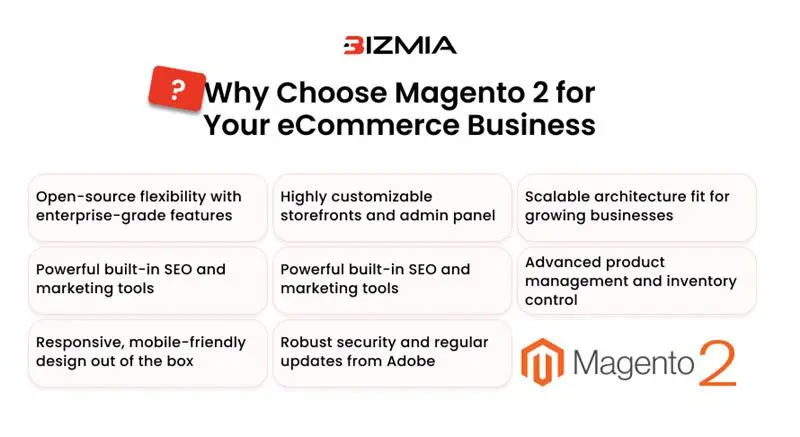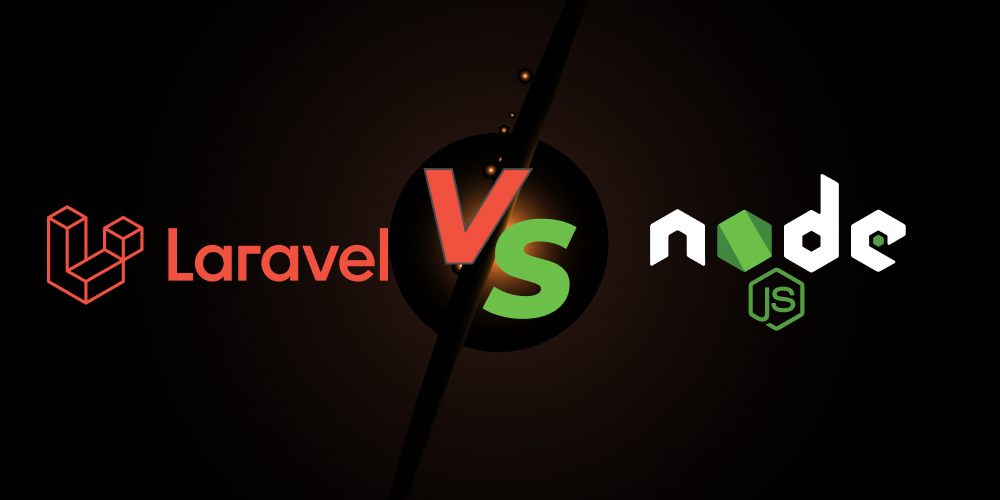Magento 2 ecommerce website development enables the owners to run their businesses online. That being said, Magento 2 is a technical platform that requires careful assistance from the technical candidates so that there are no errors or bugs in the backend of the store. For this, the most useful thing that comes to hand is Magento 2 ecommerce website development services.
These services handle all the processes from start till the completion of the project whether you want to upgrade your existing system or build one from scratch.
In this guide, we will explore Magento 2 eCommerce website development in detail touching all the important and essential factors.
Without any further ado, let’s get started.
Why Choose Magento 2 for Your Ecommerce Business?
Magento 2 offers a number of advanced features and robustness that is unmatched at any other platform. From next-level customization to theme development, and much more, Magento is a top-tier platform. Here are some of the reasons for which choosing Magento 2 for your eCommerce business would be the best choice:

Open-source flexibility with enterprise-grade features
Magento offers the best of both worlds by combining the freedom of open-source development with the robust capabilities found in enterprise-level platforms. Developers have full access to the source code, allowing them to tailor every aspect of the site, while also benefiting from a rich feature set that includes advanced marketing, SEO, and catalog management tools. This makes Magento a powerful choice for businesses that want complete control without sacrificing scale or functionality.
Highly customizable storefronts and admin panel
With Magento, the storefront design and admin interface can be customized down to the smallest detail. Businesses can create unique, branded shopping experiences tailored to their target audience using custom themes, layouts, and modules. The admin panel is equally flexible, allowing for tailored workflows, user permissions, and reporting dashboards that suit your internal operations and team structure.
Scalable architecture fit for growing businesses
Magento is built with scalability in mind. Whether you’re serving hundreds or millions of customers, Magento’s architecture is designed to handle increasing traffic, product volume, and transaction load without compromising performance. As your business grows, you can add features, integrate systems, and expand to new markets without needing to replatform.
Powerful built-in SEO and marketing tools
Out of the box, Magento provides a strong foundation for search engine visibility and online marketing. It supports SEO-friendly URLs, metadata customization, XML sitemaps, canonical tags, and schema markup. Additionally, marketing tools like promotions, upsells, email reminders, and customer segmentation make it easy to engage users and drive conversions directly from the backend.
Advanced product management and inventory control
Magento’s product management system is highly sophisticated, supporting everything from simple items to configurable, bundled, and downloadable products. Features like multi-source inventory, real-time stock tracking, and bulk editing make it easy to manage large catalogs efficiently. Admins can also set custom attributes, manage pricing rules, and automate reordering to streamline operations.
Seamless integration with third-party extensions
Magento’s modular framework allows it to connect effortlessly with a wide range of third-party services and extensions. Whether you need to plug in a payment gateway, analytics tool, CRM, ERP, or marketing platform, Magento’s marketplace offers thousands of vetted integrations. Custom APIs can also be developed for unique use cases, making the platform highly adaptable.
Responsive, mobile-friendly design out of the box
Modern shoppers demand seamless experiences across devices, and Magento delivers with built-in responsive design capabilities. Whether users are browsing on desktop, tablet, or mobile, Magento themes are optimized to provide consistent speed, usability, and checkout flow. This improves engagement and conversion rates while meeting Google’s mobile-first indexing requirements.
Robust security and regular updates from Adobe
Security is a top priority for any eCommerce business, and Magento is equipped with enterprise-grade protections. The platform receives regular updates and security patches from Adobe, and it supports features like two-factor authentication, CAPTCHA, encrypted connections (SSL), and custom admin paths. With proper configuration, Magento stores can be hardened against threats while maintaining PCI compliance.
Checklist for Magento eCommerce Website Development
When developers work on Magneto 2 ecommerce website development, there are certain tasks that need to be checked off so that they don’t miss out.
Below is a complete checklist for Magento eCommerce website development that can help you make more of it:
1. Pre-Development Planning
This is the first stage of the ecommerce website development. It helps in mapping out the details and finalizing all the technilcialities you will be ollowing in the process later.
- Define clear business goals (e.g., B2C, B2B, or hybrid model).
- Decide whether to use Magento Open Source or Adobe Commerce.
- Understand your audience and build user personas.
- Map out your product catalog structure: categories, product attributes, and variants.
- Choose a suitable hosting provider optimized for Magento.
- Plan for integrations with CRM, ERP, payment gateways, and marketing tools.
- Design wireframes or mockups for key website pages.
2. Magento Installation and Setup
The next step is installation and setup on which the basis of the entire process depends. Make sure that it is done seamlessly so experience no other issues in the process later.
- Install the latest version of Magento.
- Configure the Magento environment using Composer and set up necessary cron jobs.
- Enable caching and switch to production mode for performance.
- Establish separate development, staging, and live environments.
3. Theme Development and Design
- Choose between using Magento’s default theme or a custom one.
- Customize the theme to match your brand’s visual identity.
- Ensure the design is mobile-responsive and user-friendly.
- Focus on navigation, layout, and call-to-actions for better UX.
- Follow accessibility best practices.
- 4. Product and Catalog Management
4. Create product attribute sets and assign relevant attributes.
- Add different product types (simple, configurable, virtual, downloadable, bundled).
- Upload high-quality product images with SEO-friendly alt tags.
- Set up inventory management and stock alerts.
- Create and organize categories and subcategories.
- Set up layered navigation for easy filtering.
- Configure pricing rules like tiered pricing, discounts, and promotions.
5. Payment, Shipping, and Tax Configuration
- Enable preferred payment methods (credit card, PayPal, bank transfer, etc.).
- Configure shipping options such as flat rates, table rates, or carrier-based.
- Set up regional tax rules and zones.
- Customize checkout steps and order confirmation settings.
6. Customer and Account Settings
- Configure customer groups and user roles.
- Set up account registration and login options.
- Enable guest checkout if required.
- Build customer dashboards for tracking orders, wishlist, and personal info.
- Add loyalty or rewards features if part of your model.
7. Extensions and Integrations
- Identify essential third-party extensions (avoid installing unnecessary ones).
- Integrate tools for email marketing, CRM, analytics, and support.
- Connect Google Analytics and Google Tag Manager.
- Ensure all extensions are compatible with your Magento version.
- Test all integrations thoroughly.
8. Performance Optimization
- Enable full-page caching (e.g., Varnish).
- Minify CSS, JavaScript, and HTML files.
- Optimize all images for web to reduce load time.
- Use lazy loading and defer JavaScript where needed.
- Monitor speed with tools like GTmetrix or Google PageSpeed Insights.
9. Security Measures
- Install an SSL certificate and use HTTPS.
- Change the default admin URL for security.
- Enforce strong password policies and enable two-factor authentication.
- Set file permissions correctly.
- Schedule regular backups and updates.
- Protect forms using CAPTCHA and enable security patches.
10. SEO Setup
- Create SEO-friendly URLs and unique meta titles and descriptions.
- Implement structured data (schema markup) for products and breadcrumbs.
- Generate and upload a sitemap.xml and robots.txt.
- Set up canonical tags to avoid duplicate content issues.
- Plan for regular content updates through a blog or knowledge base.
11. Testing and Quality Assurance
- Test all customer journeys including registration, login, cart, and checkout.
- Validate mobile responsiveness across different devices.
- Ensure browser compatibility for Chrome, Safari, Firefox, and Edge.
- Test transactional emails and contact forms.
- Conduct user acceptance testing with key team members.
- Address bugs and performance issues before launch.
12. Launch Preparation
- Migrate final product data and customer records.
- Point the live domain and configure DNS.
- Reindex the site and clear all caches.
- Enable maintenance mode during migration.
- Conduct final pre-launch checks across all systems.
13. Post-Launch Monitoring
- Track performance via Google Analytics and Search Console.
- Monitor order flow, payment success rates, and customer feedback.
- Set up regular backups and error logging.
- Schedule future performance audits and security reviews.
- Begin SEO optimization and content marketing efforts.
Our Magento 2 eCommerce Web Development Services
We provide full-scale Magento 2 web development services whether it is about store setup, third-party apps integration, Magento 2 theme development, web development, SEO< performance, payment gateways or post launch, our team is packed with skilled candidates. Below is the list of our Magento 2 ecommerce development services:
Custom Magento 2 Store Design and Development
We craft tailored Magento 2 stores that align with your brand identity and user expectations. From wireframes to launch, every detail—from UX to responsive design—is built to enhance engagement and drive conversions across devices.
Magento 2 Migration and Upgrades
Whether you’re moving from Magento 1 or another platform, we ensure a smooth migration to Magento 2 with zero data loss and minimal downtime. Our team also handles version upgrades, keeping your store secure, stable, and up to date.
Custom Extension and Module Development
Need a feature that Magento doesn’t offer out of the box? We build custom extensions and modules that add the exact functionality your business requires—seamlessly integrated and performance-tested for reliability.
Magento 2 Performance Optimization
Slow stores hurt sales. We fine-tune Magento 2 performance by improving load times, optimizing caching and indexing, minimizing resource usage, and ensuring your store can scale as traffic grows.
SEO & Conversion Optimization
We optimize Magento 2 stores for both search engines and shoppers. From technical SEO to conversion-focused layouts, our approach helps you rank higher and turn more visitors into customers.
Magento 2 Support and Maintenance
Our ongoing support and maintenance services keep your Magento 2 store running smoothly. We handle updates, security patches, bug fixes, and performance checks—so you can focus on growth without tech headaches.
Hire Magento 2 Developers for eCommerce Web Development Services
Looking for the best talent that can help you setup Magento store? Hire Magento 2 developers from Bizmia, as we offer 48-hour quick hiring that enable you to onboard developers quickly, so you can start your project.
Our developers have all the technical skills and expertise backed up with experience. You can select from our different engagement models based on your project requirements and hiring needs.
Book a meeting with us today!
Frequently Asked Questions
How long does it take to build a custom Magento 2 store?
Timelines vary based on complexity, but a typical custom Magento 2 store takes 6–12 weeks from planning to launch. This includes design, development, testing, and deployment.
Can you migrate my existing store to Magento 2 without data loss?
Yes. We handle full migrations—including products, customers, orders, and content—ensuring no data loss and minimal downtime during the transition.
Do you offer ongoing support after the Magento 2 site goes live?
Absolutely. We provide continuous support, covering everything from security updates and bug fixes to performance monitoring and feature enhancements.












